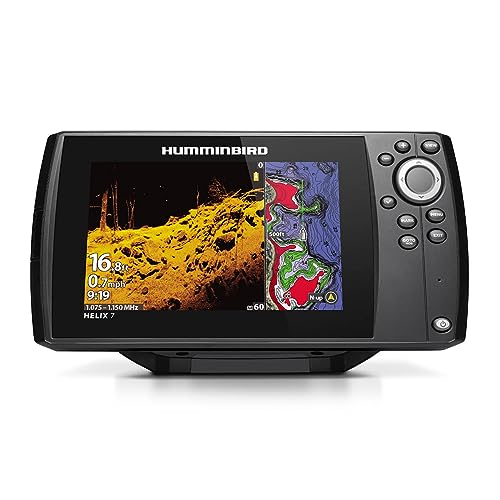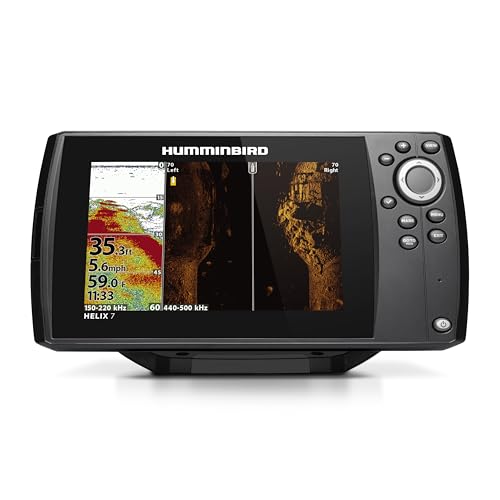
Our rankings are cleverly generated from the algorithmic analysis of thousands of customer reviews about products, brands, merchant’s customer service levels, popularity trends, and more. The rankings reflect our opinion and should be a good starting point for shopping. By purchasing the products we rank, you’ll get the lowest price we found while we may receive a commission at no cost to you, which will help us continue to provide you with value.
Advertising Disclosure
Fish Finders Depth Finders of 2025
Save up to 23% off
- Best Choice
1
 Humminbird
HumminbirdHumminbird HELIX 7 G4 Fish Finder CHIRP, MEGA Down Imaging, GPS
Main highlights-
MEGA Down Imaging provides up to 3X more detail than standard sonar.
Unprecedented Underwater Clarity
-
Perfect for anglers needing detailed underwater views and navigation support.
Ideal for Versatile Fishing
-
Customers appreciate the clarity and user-friendly interface of the fish finder.
Praised Ease of Use
-
-
How do we rank?
Powerful technology We scan thousands of products and stores, analyzing reviews to find what matters most to users like youCareful review Our team ensures quality, value, and fit based on real user feedbackTrusted insights AI and human analysis guide your decisions, reflecting real user prioritiesReal users impactThousands of users trust our site daily
Based on millions of stores and reviews
Shoppers influence our rankings
Analyzing top stores
- Value for Money
2
 Humminbird
HumminbirdHumminbird Helix 7 G4 Fish Finder with Chirp Side Imaging, GPS
Main highlights-
Experience superior detail with CHIRP Down Imaging and Dual Spectrum CHIRP sonar for easy fish detection.
CHIRP Sonar Clarity
-
Equipped with internal GPS and Humminbird Basemap, perfect for confident navigation and fishing.
Ideal for Navigation
-
Customers praise the clear graphics and easy-to-read display for enhanced usability.
Clear Display Graphics
-
3
LUCKYLUCKY Kayak Portable Fish Depth Finder Water Handheld Fish Finder Sonar Castable Kayak Boat Fishfinder Transducer Fishing LCD Display FFC1108
Main highlights-
The LUCKY Fish Finder is handheld, portable, and user-friendly, ideal for kayak and boat fishing.
Portable and Easy to Use
-
Perfect for boat, ice, and shore fishing in both freshwater and saltwater.
Versatile Fishing Applications
-
Customers frequently praise its ability to alert when fish are present.
Effective Fish Detection
-
4
HumminbirdHumminbird PiranhaMAX 4 Fish Finder, Down Imaging
11% OffMain highlights-
Offers narrow and wide beams for detailed fish and structure identification.
Dual Beam Sonar Feature
-
Perfect for small boats and personal fishing adventures.
Ideal for Recreational Fishing
-
Down Imaging provides clear visuals of underwater objects and structures.
Customer Praised Imaging
-
5
ReelSonarReelsonar Portable Fish Finder Accurate Fish Depth Finder with Depth Range of 135 feet 10+ Hours Battery Life with iOS & Android App Wireless
14% OffMain highlights-
Provides real-time, reliable depth and fish location up to 135 feet.
Accurate Depth and Fish Detection
-
Ideal for freshwater, saltwater, shore, and ice fishing with Bluetooth connectivity.
Versatile Fishing Conditions
-
Praised for its over 10-hour battery life, perfect for long trips.
Impressive Battery Life
-
-
See Today’s Deals & Prices
6
HumminbirdHumminbird Helix 5 G3 Fish Finder Chirp GPS
Main highlights-
Operate easily with softkey controls and enjoy detailed sonar views.
Keypad Control and Sonar Clarity
-
Perfect for anglers needing reliable navigation and fish finding.
Ideal for Navigation and Fishing
-
Customers love the ease of installation and use.
Praised for User-Friendliness
-
7
YoocyliiYoocylii Handheld Fish Finder Portable Fishing Kayak Fishfinder Fish Depth Finder Fishing Gear with Sonar Transducer and LCD Display
Main highlights-
Compact design with neck strap; ideal for kayaks and docks.
Portable and Versatile
-
Works well on moving kayaks under 5mph; great for ice fishing.
Ideal for Kayak Fishing
-
Accurate depth readings; highly recommended for budget-conscious anglers.
Highly Praised Depth Finder
-
8
HumminbirdHumminbird HELIX 5 G2 Fish Finder with Down Imaging, Dual Beam PLUS Sonar
Main highlights-
Down Imaging provides detailed views of underwater structures and fish.
Enhanced Underwater Clarity
-
Perfect for anglers needing detailed sonar and wide coverage.
Ideal for Versatile Fishing
-
Customers appreciate its cost-effectiveness and ease of use.
Praised for Value
-
9
LowranceLowrance HOOK Reveal 5 SplitShot - 5-inch Fish Finder with SplitShot Transducer, Preloaded C-MAP US Inland Mapping
23% OffMain highlights-
Combines CHIRP sonar and DownScan Imaging for clearer fish identification.
Enhanced Fish Detection
-
Ideal for anglers and divers with customizable maps and GPS plotting.
Versatile Usage Scenarios
-
Praised for easy setup and intuitive use, even for beginners.
User-Friendly Operation
-
10
DeeperDeeper PRO+ 2 Sonar - Portable Fish Finder and Depth Finder for Kayaks, Boats and Ice Fishing with GPS Enabled | Castable Deeper Sonar with Free User Friendly App
Main highlights-
Offers wide, mid, and narrow beams for versatility, smart technology for solid Wi-Fi connectivity, and built-in GPS for creating bathymetric maps.
Key Features
-
Perfect for elite anglers targeting specific species, mapping fishing spots from the shore, and enhancing matchplay with pinpoint accuracy and vertical jigging.
Ideal Use Cases
-
Most praised for its seamless integration into tackle boxes, exceptional accuracy, and the ability to track lures and fish with unparalleled precision.
Customer Reviews
-
Similar products on Amazon
 Free Shipping
Free ShippingLUCKY Portable Fish Finder Handheld Kayak Fish Finders Wired Fish Depth Finder Sonar Sensor Transducer for Boat Fishing Sea Fishing
The portable fish finder, with updated 2.4inch TFT color LCD screen(more clear to display), can detect and display underwater contour, water depth, water temperature and fish size(big/middle/small) and fish depth. It has two user modes: TRANSDUCER/SIMULATION. Try all functions in simulation mode and go fishing in transducer mode.$82.89
 Free Shipping
Free ShippingVenterior Portable Rechargeable Fish Finder Wireless Sonar Sensor Fishfinder Depth Locator with Fish Size, Temperature, Bottom Contour, Color Display
Castable: No more long & heavy cable for transducer. Clear Color Screen: it comes with clear color TFT LCD display (2 screen background colors selectable - black and white), which enables you to read the screen in bright sunlight or at night. It applies to lake, river, sea and other fishing environment. Suitable for fishing from a kayak or boat, casting from the shore or using for ice fishing.$85.99

Eagle 4X, 4" IPS Portrait Fish Finder with Bullet transdcuer
HIGH-VIS IPS SCREEN: IPS Screen allows for anglers to view crisp images in the daylight, with polarized sunglasses, and at extreme angles.$122.15
 Free Shipping
Free ShippingPortable Fish Finder Large HD Display Wireless Fish Finder, Fish Finders & Depth Finders for Boats with 147 feet Depth Detection Sensor, Rechargeable Castable Fish Finder Display Fish, Temp, Depth
【Various Display】Portable fish finder 2.4 inches colorful LCD Screen Fish finder with 21 operating languages, it can detect fish size icon with depth, water temperature, water depth, bottom contour, water surface$69.99
 Free Shipping
Free ShippingDeeper Start Fish Finder - Portable and Depth Finder for Recreational Fishing from Dock, Shore, Bank or Kayak | Castable Deeper Smart Sonar with Free User Friendly App
READY TO GO - Easily find where your next catch is hiding with the Deeper START Fish Finder! The lightweight and sleek design makes for a seamless reel without any messy wires or fiddly external batteries required. Ideal for shore anglers and family trips who want to get on with catching!$89.99
 Free Shipping
Free ShippingFish Finder Mount Base, Universal 360° Rotation Ball-Mount Fish Finder Bracket, Nylon & Stainless Steel Electronic Fish Finder Holder for Marine Boat Kayak Pontoon Canoe Helix Garmin, 4*Srews, 4*Nuts
【UNIVERSAL COMPATIBILITY】The fish finder mount is designed with a flat surface with various mounting holes, which is compatible with various models. You can also drill your own holes to fit your model. It is compatible with Garmin GPSMAP 162/168/175/180/180C/182/185/188/188C/232/238/276CX/580/585Plus/695/4012/721xs/722/722xs/742/742xs/923xsv/1223xsv/2208DS, Garmin ECHOMAP Plus 72cv/73cv/74cy/75cy/77cv, Garmin Striker 5 series/Striker Plus 5cv/7cv/7sv, Lowrance HDS 7/9/12/16 Carbon/HDS LIVE 7.$13.88
 Free Shipping
Free ShippingDepthTrax 2B Boat Mount In Dash Digital Depth Finder
Delivers uninterrupted depth readings from 2.5 to 600 feet on the largest display available on an In-Dash Depth Sounder up to 60 mph. Transducer Frequency-200 kHz$99.90
$109.99 Free Shipping
Free ShippingRICANK Kayak Portable Fish Depth Finder Handheld Fish Finder Contour Readout Fishfinder Ice Shore Boat Fishing Fish Detector Device with Sonar Sensor Transducer and LCD Display Gear Blue
Fishes and Contour Readout:The fish finder portable detects and displays water depth, approximate fish location, fish size, short & tall weeds, sand & rocks on bottom.$39.99
 Free Shipping
Free ShippingHawkEye DT1H Handheld Depth Finder with Temperature, 300 Feet
New$75.10




























